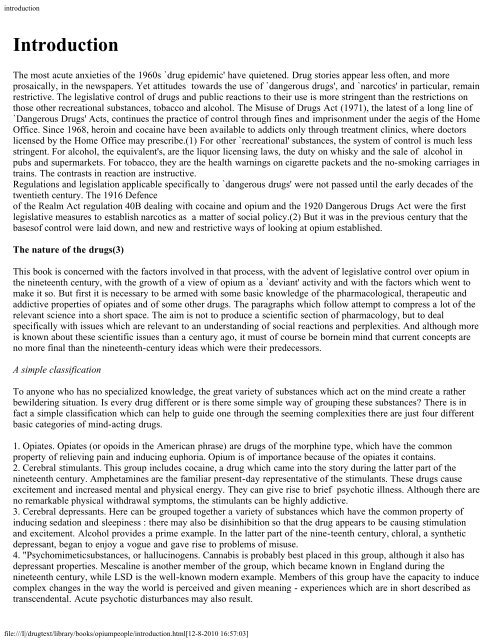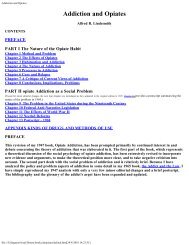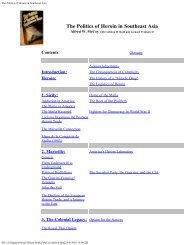opium and the people
opium and the people
opium and the people
Create successful ePaper yourself
Turn your PDF publications into a flip-book with our unique Google optimized e-Paper software.
introduction<br />
Introduction<br />
The most acute anxieties of <strong>the</strong> 1960s `drug epidemic' have quietened. Drug stories appear less often, <strong>and</strong> more<br />
prosaically, in <strong>the</strong> newspapers. Yet attitudes towards <strong>the</strong> use of `dangerous drugs', <strong>and</strong> `narcotics' in particular, remain<br />
restrictive. The legislative control of drugs <strong>and</strong> public reactions to <strong>the</strong>ir use is more stringent than <strong>the</strong> restrictions on<br />
those o<strong>the</strong>r recreational substances, tobacco <strong>and</strong> alcohol. The Misuse of Drugs Act (1971), <strong>the</strong> latest of a long line of<br />
`Dangerous Drugs' Acts, continues <strong>the</strong> practice of control through fines <strong>and</strong> imprisonment under <strong>the</strong> aegis of <strong>the</strong> Home<br />
Office. Since 1968, heroin <strong>and</strong> cocaine have been available to addicts only through treatment clinics, where doctors<br />
licensed by <strong>the</strong> Home Office may prescribe.(1) For o<strong>the</strong>r `recreational' substances, <strong>the</strong> system of control is much less<br />
stringent. For alcohol, <strong>the</strong> equivalent's, are <strong>the</strong> liquor licensing laws, <strong>the</strong> duty on whisky <strong>and</strong> <strong>the</strong> sale of alcohol in<br />
pubs <strong>and</strong> supermarkets. For tobacco, <strong>the</strong>y are <strong>the</strong> health warnings on cigarette packets <strong>and</strong> <strong>the</strong> no-smoking carriages in<br />
trains. The contrasts in reaction are instructive.<br />
Regulations <strong>and</strong> legislation applicable specifically to `dangerous drugs' were not passed until <strong>the</strong> early decades of <strong>the</strong><br />
twentieth century. The 1916 Defence<br />
of <strong>the</strong> Realm Act regulation 40B dealing with cocaine <strong>and</strong> <strong>opium</strong> <strong>and</strong> <strong>the</strong> 1920 Dangerous Drugs Act were <strong>the</strong> first<br />
legislative measures to establish narcotics as a matter of social policy.(2) But it was in <strong>the</strong> previous century that <strong>the</strong><br />
basesof control were laid down, <strong>and</strong> new <strong>and</strong> restrictive ways of looking at <strong>opium</strong> established.<br />
The nature of <strong>the</strong> drugs(3)<br />
This book is concerned with <strong>the</strong> factors involved in that process, with <strong>the</strong> advent of legislative control over <strong>opium</strong> in<br />
<strong>the</strong> nineteenth century, with <strong>the</strong> growth of a view of <strong>opium</strong> as a `deviant' activity <strong>and</strong> with <strong>the</strong> factors which went to<br />
make it so. But first it is necessary to be armed with some basic knowledge of <strong>the</strong> pharmacological, <strong>the</strong>rapeutic <strong>and</strong><br />
addictive properties of opiates <strong>and</strong> of some o<strong>the</strong>r drugs. The paragraphs which follow attempt to compress a lot of <strong>the</strong><br />
relevant science into a short space. The aim is not to produce a scientific section of pharmacology, but to deal<br />
specifically with issues which are relevant to an underst<strong>and</strong>ing of social reactions <strong>and</strong> perplexities. And although more<br />
is known about <strong>the</strong>se scientific issues than a century ago, it must of course be bornein mind that current concepts are<br />
no more final than <strong>the</strong> nineteenth-century ideas which were <strong>the</strong>ir predecessors.<br />
A simple classification<br />
To anyone who has no specialized knowledge, <strong>the</strong> great variety of substances which act on <strong>the</strong> mind create a ra<strong>the</strong>r<br />
bewildering situation. Is every drug different or is <strong>the</strong>re some simple way of grouping <strong>the</strong>se substances? There is in<br />
fact a simple classification which can help to guide one through <strong>the</strong> seeming complexities <strong>the</strong>re are just four different<br />
basic categories of mind-acting drugs.<br />
1. Opiates. Opiates (or opoids in <strong>the</strong> American phrase) are drugs of <strong>the</strong> morphine type, which have <strong>the</strong> common<br />
property of relieving pain <strong>and</strong> inducing euphoria. Opium is of importance because of <strong>the</strong> opiates it contains.<br />
2. Cerebral stimulants. This group includes cocaine, a drug which came into <strong>the</strong> story during <strong>the</strong> latter part of <strong>the</strong><br />
nineteenth century. Amphetamines are <strong>the</strong> familiar present-day representative of <strong>the</strong> stimulants. These drugs cause<br />
excitement <strong>and</strong> increased mental <strong>and</strong> physical energy. They can give rise to brief psychotic illness. Although <strong>the</strong>re are<br />
no remarkable physical withdrawal symptoms, <strong>the</strong> stimulants can be highly addictive.<br />
3. Cerebral depressants. Here can be grouped toge<strong>the</strong>r a variety of substances which have <strong>the</strong> common property of<br />
inducing sedation <strong>and</strong> sleepiness : <strong>the</strong>re may also be disinhibition so that <strong>the</strong> drug appears to be causing stimulation<br />
<strong>and</strong> excitement. Alcohol provides a prime example. In <strong>the</strong> latter part of <strong>the</strong> nine-teenth century, chloral, a syn<strong>the</strong>tic<br />
depressant, began to enjoy a vogue <strong>and</strong> gave rise to problems of misuse.<br />
4. "Psychomimeticsubstances, or hallucinogens. Cannabis is probably best placed in this group, although it also has<br />
depressant properties. Mescaline is ano<strong>the</strong>r member of <strong>the</strong> group, which became known in Engl<strong>and</strong> during <strong>the</strong><br />
nineteenth century, while LSD is <strong>the</strong> well-known modern example. Members of this group have <strong>the</strong> capacity to induce<br />
complex changes in <strong>the</strong> way <strong>the</strong> world is perceived <strong>and</strong> given meaning - experiences which are in short described as<br />
transcendental. Acute psychotic disturbances may also result.<br />
file:///I|/drugtext/library/books/<strong>opium</strong><strong>people</strong>/introduction.html[12-8-2010 16:57:03]





